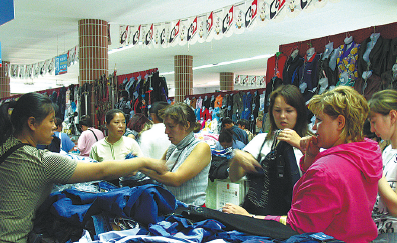Region emerges as world trade hub

As a window of opening-up in North China, the Inner Mongolia autonomous region plays an important role in the country’s Belt and Road Initiative.
Luo Qing, deputy mayor and deputy Party chief of Hohhot, the region’s capital city, said that the city will strengthen its involvement in the China-Russia-Mongolia Economic Corridor.
The autonomous region has mainly established international trade links with Asian countries, among which Mongolia ranks No. 1, followed by Russia.
Sunflower seeds are the most exported local product, while copper ore and its concentrate are top of the imported goods list.
By 2016, the number of foreign-invested enterprises in the autonomous region reached 150, with the total combined contract amount standing at $587 million. These enterprises cover industries such as manufacturing, services and new energy power generation.
The local government has organized investment and trade forums, a Sino-Russian exhibition, an Indonesian electromechanical exhibition and other activities to enhance cooperation between companies.
The local government is encouraging enterprises to participate in international engineering projects. Foreign labor service platforms have been constructed to link training schemes for contract workers at higher educational institutes and vocational technical schools. The region’s legal and operational environments have been optimized to enhance multinational labor cooperation.

Russian customers buy clothes in a market at Manzhouli, where Chinese and Russian business people have set up stores. [Photo provided to China Daily]
China-Europe Block train
The first train connecting Irkutsk in Russia with Ulanqab of Inner Mongolia set off recently, marking the region’s establishment as a new junction along the Belt and Road routes.
The train, which loaded 42 containers, transported wood from Russia, across Mongolia and finally to China in 10 days.It also took Chinese electronic products, daily goods and mechanical equipment to other foreign countries, as reported by Inner Mongolia Daily in June.
“It reduced the transportation time by three days, which significantly decreased the cost of transportation,” said Ma Chengyu, deputy general manager of Qisumu (Sino-Europe railway) Logistics Park.
North China’s Inner Mongolia links eight provinces and cities. It borders Russia and Mongolia, with an area of 460,000 square miles, comprising 12.3 percent of China’s total land surface.
In 2016, the number of inbound and outbound trains in China was 1,702, of which 59.4 percent traveled through Inner Mongolia.
The autonomous region has 18 ports open to foreign countries and regions, contributing to 65 percent of Sino-Russian land transportation and 95 percent of Sino-Mongolian cargo transportation.
Manzhouli , the biggest land port to Russia, has been processing imported sunflower seeds, oats, buckwheat and flaxseed since 2016.
Zhang Jiamin ,vice -chairman of the Inner Mongolia autonomous region, said, “Inner Mongolia and Mongolia maintain close links due to their historical origin. The region also plays an active role in Sino-Russian communications because we are very close geographically.”
The region has established business exchanges with 55 countries and regions along the Belt and Road, Zhang said.
Inner Mongolia’s foreign trade volume reached $11.7 billion last year, two thirds of which came from countries involved in the Belt and Road Initiative, data from the Inner Mongolia bureau of commerce showed.
Overseas investment in Russia totaled $1.13 billion by 2016, and in Mongolia, $1.81 billion.
The volume of freight traffic totaled 79 million metric tons, up 35.4 percent year-on-year. Passenger capacity reached around 53 million, 23.6 percent higher than 2015.







